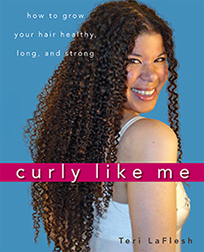
Available now!
Curly Like Me, the off-the-grid, do-it yourself owner's manual for tightly curly hair, is ready for ordering. Grab your copy today!

Every purchase made from
this site (through Amazon)
helps support it — and it
doesn't cost you anything
extra.
|
|
In the ingredient descriptions: Good means that I like to see this in a product's list of ingredients. Okay means this product appears safe for a curly person like me to use. Caution means that this ingredient may not be good in some hair care products, or for some people. Avoid means this ingredient may hurt your hair. If you see this ingredient in a hair product, it's best to put it down and walk away.
|
|
| |
Phenoxyethanol
Okay
Preservative believed to be less irritating than others. Can also be used as a fragrance [Winter pg 399].
Phenoxyethanol is mild to the skin but can be hugely irritating to eyes—though it isn't found to be irritating in the tiny amounts normally used in products. Surprisingly, it also has some conditioning and emollient properties.
This is an oily, white to off-white liquid that smells a bit like roses. It doesn't dissolve easily in water, but will in ethanol or alkaline environments. Though Phenoxyethanol kills bacteria, it doesn't kill all types of them, so it's often combined with other anti-bacterial ingredients to kill all bacteria that may form in a product. Because it is conditioning, Phenoxyethanol may be found more often in conditioners or cosmetics, or shampoos meant to be moisturizing. The problem with Phenoxyethanol is that you do have to use higher amounts to do the job, and since it smells like roses, it may be hard to cover up the scent (if you aren't wanting your product to smell rosy) [Hunting (Shampoo) pg 317-318].
This is in one of my favorite, go to conditioners that I've been using for well over ten years. It has not caused any problems as far as conditioning and defining my hair. That's why I'm calling it a
* * * Tried and true ingredient * * *
See also:
Preservative
Source(s):
Winter Hunting
|
|
References:
Applewhite, Thomas H., ed. Proceedings of the World Conference on Lauric Oils: Sources, Processing, and Applications
AOCS Publishing, 1994.
Barel, André O., Marc Paye, and Howard I. Maibach., eds. Handbook of Cosmetic Science and Technology, Second Edition
Marcel Dekker, Inc., 2001.
Begoun, Paula. Don’t Go Shopping for Hair-Care Products Without Me. 3rd Edition.
Renton: Beginning Press, 2005.
Begoun, Paula. The Beauty Bible.
Renton: Beginning Press, 2002.
Begoun, Paula. Don’t Go to the Cosmetics Counter Without Me.
Renton: Beginning Press, 2003.
Bellum, Sarah, ed. The Beauty Brains: Real Scientists Answer Your Beauty Questions
New York: Brains Publishing, 2008.
Gottschalk, Tari E. and McEwen, Gerald N, Jr. PhD, eds. International Cosmetic Ingredient Dictionary and Handbook, Tenth Edition 2004, Volumes 1-4.
Washington D. C.: The Cosmetic, Toiletry, and Fragance Association, 2004.
Halal, John Hair Structure and Chemistry Simplified, Fifth Edition
Albany: Milady, 2002.
Hunting, Anthony L.L. Encyclopedia of Conditioning Rinse Ingredients.
Cranford, NJ: Micelle Press, Inc., 1987.
Hunting, Anthony L.L. Encyclopedia of Shampoo Ingredients.
Cranford, NJ: Micelle Press, Inc., 1983.
Johnson, Dale H. (Ed.). Hair and Hair Care, Cosmetic Science and Technology Series. Vol. 17.
New York: Marcel Dekker, 1997. Print.
Nnanna, Ifendu A. and Jiding Xia., eds. Protein-Based Surfactants: Synthesis: Physicochemical Properties, and Applications (Surfactant Science)
Madison Heights: CRC, 2001.
Quadflieg, Jutta Maria. Fundamental properties of Afro-American hair as related to their straightening/relaxing behaviour.
Diss. U of Rheinisch-Westfälischen Technischen Hochschule Aachen, 2003.
Schueller, Randy and Perry Romanowski, eds. Conditioning Agents for Hair and Skin.
New York: Marcel Dekker, Inc., 1999.
Winter, Ruth M.S. A Consumer's Dictionary of Cosmetic Ingredients: Complete Information About the Harmful and Desirable Ingredients Found in Cosmetics and Cosmeceuticals
New York: Three Rivers Press, 2005.
Zviak, Charles., ed. The Science of Hair Care (Dermatology)
New York: Marcel Dekker, Inc., 1986.
|
|